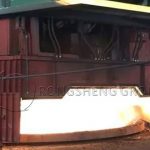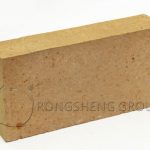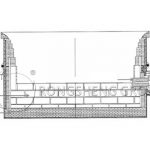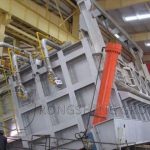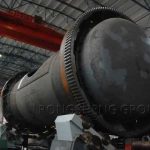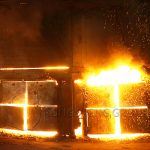There are many types of ferroalloys. How to choose the appropriate furnace lining structure for the production of different ferroalloys? Is the currently promoted condensing furnace lining suitable for the production of all ferroalloys? In response to this problem, Li Jianwei believes that not all ferroalloy production is suitable for condensation furnace linings, and the choice of furnace lining structure should depend on the density of ferroalloys. Ferroalloys with low density are preferred for thermal insulation furnace linings, such as calcium carbide, ferrosilicon alloy and metallic silicon. High-density ferroalloys are suitable for condensing furnace linings, such as high-carbon ferromanganese, high-carbon ferrochrome, manganese-silicon alloy, ferrochrome, ferronickel, nickel-chromium, etc. Li Jianwei also pointed out that in addition to the density of ferroalloy, whether to choose a condensing furnace lining is also directly related to whether the smelting process is slag-containing smelting or slag-free smelting.
![]()
Selection of Furnace Lining Structures in Different Ferroalloy Industries
Regarding how to select the furnace lining structure in the ferroalloy industry, some researchers conducted an on-site investigation at a metallurgical company where they work. At present, the company has about 80 submersible furnaces for ferrosilicon production, with an annual output of 1.6 million tons. Its scale is not small in the world. It has 24 submersible furnaces for calcium carbide, with an annual output of more than 1.8 million tons, and its production capacity ranks fifth in the country. Currently, both ferrosilicon and calcium carbide production use an insulated furnace lining structure. Under the premise of correct operation, the average life of the furnace lining can reach more than 10 years. According to the company’s nearly 20 years of industrial production experience, the use of thermal insulation furnace linings has little to do with the density of ferroalloys.
Take ferrosilicon smelting as an example. Ferrosilicon smelting is a slag-free smelting. Every time 1 ton of ferrosilicon is produced, only 20~60kg of slag/t is produced. The success of the condensing furnace lining depends on the formation of a slag insulation shell on the furnace wall. Therefore, it is difficult for ferrosilicon smelting to achieve the effects of other slag-containing smelting by using condensing furnace linings. In addition, the amount of melt in the furnace is small during ferrosilicon smelting. Taking a certain model of the company’s ferrosilicon ore furnace as an example, the furnace body diameter is 11m and 11t of iron is produced every two hours. Assuming that the ferrosilicon melt is laid flat on the bottom of the furnace, the deepest depth of the melt before tapping is only 3.6cm. In other words, the height at which the melt contacts the furnace lining is very limited. In the actual production of ferrosilicon, the melt is not spread flat on the bottom of the furnace, but is mainly concentrated under the three electrodes. Therefore, the ferrosilicon melt has almost no contact with the inner wall of the furnace lining. It can be seen that ferrosilicon is not suitable for the use of condensing furnace linings, and traditional insulation lining structures should be selected. Through temperature measurement and heat dissipation calculation comparison, Kang Guozhu believes that the water-cooled condensing furnace lining has better thermal insulation performance, so he speculates that the use of condensing furnace linings for ferrosilicon is more suitable for ferrosilicon production. However, the researchers’ analysis shows that their speculations did not take into account actual production conditions.
Furnace Lining Materials for the Ferroalloy Industry
- (1) As submerged arc furnaces develop towards larger sizes, the working temperature and usage environment in the furnace are becoming more and more demanding. The service life of the furnace lining directly determines the service life of the submerged arc furnace. Causes of damage to the furnace lining include softening and corrosion of high-temperature refractory materials, chemical erosion of the refractory lining by slag, molten metal and reaction atmosphere, and mechanical erosion of the charge and slag. The coupling effect of these three aspects will accelerate the damage rate of the furnace lining.
- (2) There are many types of ferroalloys, and the conditions in the furnace during smelting of different ferroalloys are different. Within the same submerged arc furnace, the working environment at different locations is also quite different. Therefore, refractory materials should be reasonably selected according to specific conditions. The working environment at the slag line at the bottom of the furnace wall and under the furnace bottom electrode is the worst, and carbonaceous materials and magnesia materials are mostly used. The taphole location, which is most vulnerable to damage, usually uses carbon or silicon carbide materials.
- (3) Thermal insulation furnace lining is currently the most widely used furnace lining structure. In order to improve the service life of the furnace lining, the integral lining gradually replaces the refractory brick masonry. With the continuous improvement of ferroalloy smelting requirements, the concept of condensing furnace lining emerged. The condensation furnace lining uses high thermal conductivity refractory materials and thin furnace lining, and cooperates with the forced cooling of the furnace wall to make the slag form a self-protecting solidification shell on the inner wall of the furnace lining. It has been successfully used in a variety of ferroalloy submerged furnaces at home and abroad. This furnace lining structure can extend the service life of the furnace lining and reduce production costs. It is the main development direction of submerged arc furnace linings in the future.
The key to the success of the condensation-type furnace lining structure is the formation of a self-protective layer of slag with low thermal conductivity, so it is not suitable for the production of ferroalloys smelted by slag-free smelting. The two structures of insulating furnace lining and condensing furnace lining basically meet the smelting needs of all ferroalloy products. According to the actual production situation, a more reasonable furnace lining structure is designed, combined with new high-quality refractory materials, to provide a more reasonable furnace lining structure for future submerged arc furnaces.



